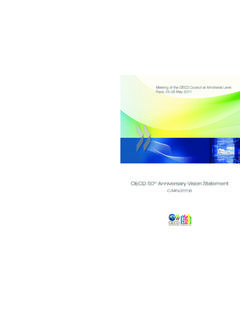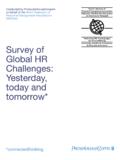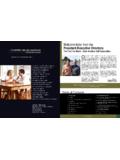Transcription of Anti-money laundering and terrorist financing measures and ...
1 Fatf GUIDaNCEAnti- money laundering and terrorist financing measures and Financial InclusionFebruary 2013 FINANCIAL ACTION TASK FORCE The Financial Action Task Force (FATF) is an independent inter-governmental body that develops and promotes policies to protect the global financial system against money laundering , terrorist financing and the financing of proliferation of weapons of mass destruction. The FATF Recommendations are recognised as the global Anti-money laundering (AML) and counter- terrorist financing (CFT) standard. For more information about the FATF, please visit the website: 2013 FATF/OECD.
2 All rights reserved. No reproduction or translation of this publication may be made without prior written permission. Applications for such permission, for all or part of this publication, should be made to the FATF Secretariat, 2 rue Andr Pascal 75775 Paris Cedex 16, France (fax: +33 1 44 30 61 37 or e-mail: Photocredits coverphoto: Thinkstock Anti-money laundering and terrorist financing measures and financial inclusion FATF Guidance 2013 1 Contents TABLE OF ACRONYMS .. 3 EXECUTIVE SUMMARY .. 5 INTRODUCTION BACKGROUND AND CONTEXT .. 7 Preliminary remarks .. 7 Scope of the February 2013 Guidance Paper .. 9 Objectives of the Guidance.)
3 9 Target Audience .. 10 Status and Content of the Guidance Paper .. 10 CHAPTER 1 STATEMENT OF THE PROBLEM .. 12 What is Financial Inclusion?.. 12 State of Financial Inclusion .. 12 The Diversity of the Financially Excluded and Underserved Groups .. 13 Challenges of Financial Exclusion .. 13 Balancing AML/CFT Requirements and Financial Inclusion .. 15 CHAPTER 2 - GUIDANCE ON ACTION TO SUPPORT FINANCIAL INCLUSION .. 17 I. Preliminary Remarks .. 17 II. Overview of the Risk-Based Approach of the FATF .. 18 Developing a risk assessment A key step to identifying low risk and lower risk situations .. 19 III. The flexibility offered by the FATF Recommendations in proven low risk scenarios: the exemptions.
4 23 3. 1. The proven low risk exemption .. 24 The de minimis exemption .. 25 IV. The FATF Recommendations in the light of financial inclusion objectives .. 27 Customer Due Diligence (Recommendation 10) .. 27 Record-keeping requirements (Recommendation 11) .. 39 Suspicious transactions reporting (Recommendation 20) .. 40 The use of agents to carry out AML/CFT functions .. 41 Internal controls .. 46 Other relevant issues .. 48 49 ANNEXES .. 50 BIBLIOGRAPHY AND SOURCES .. 87 Anti-money laundering and terrorist financing measures and financial inclusion FATF Guidance 2 2013 Anti-money laundering and terrorist financing measures and financial inclusion FATF Guidance 2013 3 TABLE OF ACRONYMS AML/CFT Anti-money laundering and Countering the financing of Terrorism APG Asia-Pacific Group on money laundering CDD Customer Due Diligence DNFBP Designated Non-Financial Business or Profession FATF Financial Action Task Force FSRB FATF-Style Regional Body GPFI Global Partnership for Financial Inclusion IN Interpretive Note INR.
5 X Interpretive Note to Recommendation X KYC Know Your Customer PEP Politically Exposed Person RBA Risk-Based Approach SIP Strategic Implementation Planning STR Suspicious Transaction Report LCC Low Capacity Country Anti-money laundering and terrorist financing measures and financial inclusion FATF Guidance 4 2013 Anti-money laundering and terrorist financing measures and financial inclusion FATF Guidance 2013 5 EXECUTIVE SUMMARY The promotion of formal financial systems and services is central to any effective and comprehensive AML/CFT regime. However, applying an overly cautious approach to AML/CFT safeguards can have the unintended consequence of excluding legitimate businesses and consumers from the formal financial system.
6 The FATF has therefore defined a Guidance to provide support in designing AML/CFT measures that meet the national goal of financial inclusion, without compromising the measures that exist for the purpose of combating crime. The main aims of the document are to develop a common understanding of the FATF Standards1 The Guidance paper was initially published in 2011 and was revised following the adoption of the new set of FATF Recommendations in 2012. It is non-binding and does not override the purview of national authorities. It highlights the need to better inform the assessors and the assessed countries of the financial inclusion dimension of the AML/CFT national frameworks.
7 That are relevant when promoting financial inclusion and explicit the flexibility that the Standards offer, in particular the risk-based approach (RBA), enabling jurisdictions to craft effective and appropriate controls. The Guidance focuses on facilitating access to formal services for financially excluded and underserved groups, including low income, rural sectors and undocumented groups. It extensively explores the initiatives taken in developing countries as it is where the challenge is the greatest. The analysis is based on a number of countries experiences and initiatives to address financial inclusion within the AML/CFT context.
8 The Guidance is based on the important assumption that financially excluded and underserved groups, including low income, rural sector and undocumented groups, in both developing and developed countries should not be automatically classified as presenting lower risk for ML/TF. The Guidance gives an overview of the RBA which is a central element of the 2012 Standards. The greater recognition of a risk-sensitive approach to implement AML/CFT measures including in particular an approach that takes into consideration the risks of financial exclusion and the benefits of bringing people into the formal financial system will be a key step for countries that wish to build a more inclusive financial system.
9 The application of the RBA will be based on an assessment of risks which will help countries and financial institutions understand, identify and assess risks and apply mitigation and management measures that are risk-sensitive. This may include low risks, which could benefit from an exemption and lower risks, which could be applied simplified AML/CFT measures . The Guidance reviews the different steps of the AML/CFT process (Customer Due Diligence (CDD), record-keeping requirements, report of suspicious transactions, use of agents, internal controls), and 1 The FATF Standards comprise the FATF Recommendations and their Interpretive Notes.
10 Anti-money laundering and terrorist financing measures and financial inclusion FATF Guidance 6 2013 for each of them presents how the Standards can be read and interpreted to support financial inclusion. In this context: For CDD a distinction needs to be made between the pure identification and the verification steps. An RBA can be introduced to carry out the CDD requirements. Examples of lower risk scenarios and of simplified CDD measures are outlined. Countries usually define the reliable, independent source documents which can be used to verify customers identity, and financial institutions can also define a risk based approach with verification processes proportionate to ML/TF risk.















